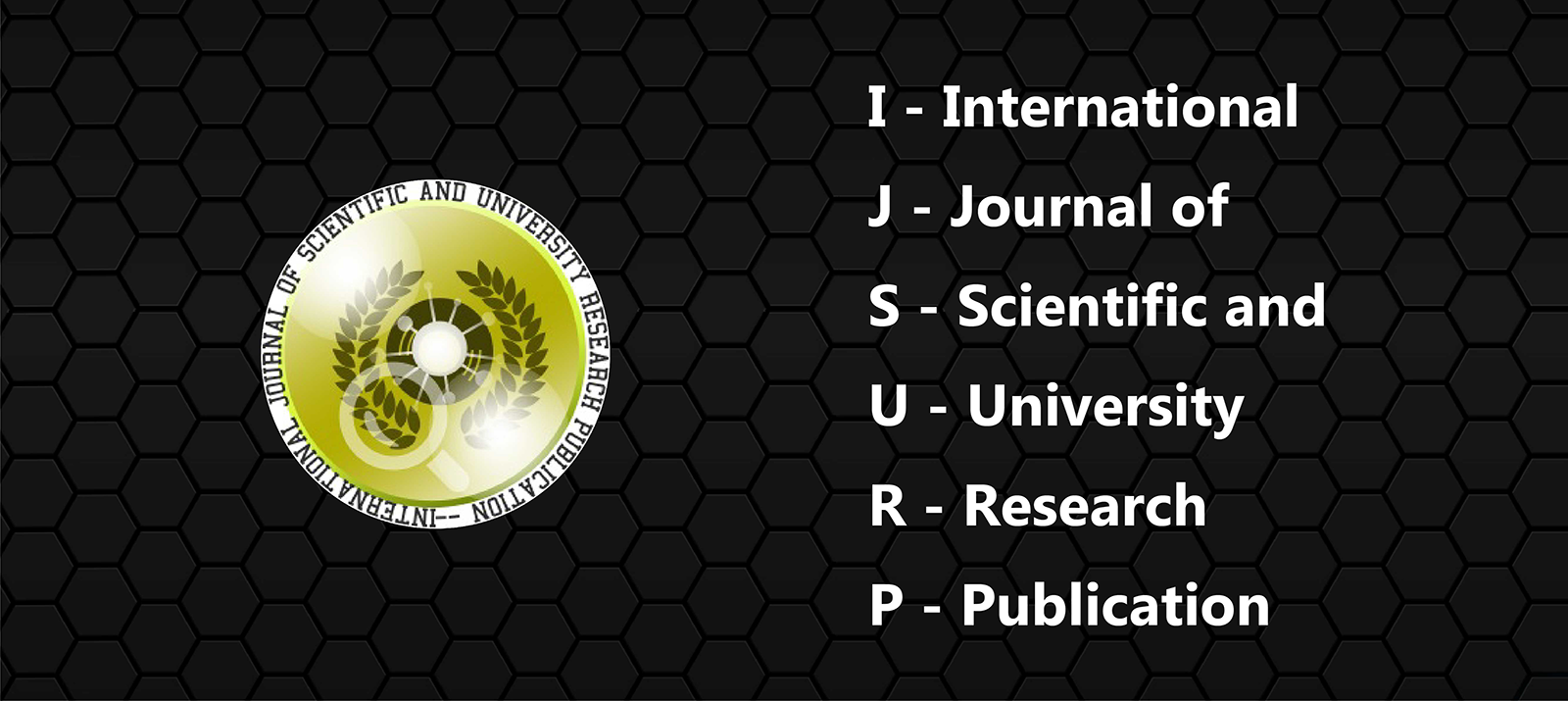
Study of Surgical Site Infections and antibiotic susceptibility pattern of isolates at a tertiary care hospital in Amritsar
Authore(s) : Dr. Bimla Devi || ProfessorDepartment of MicrobiologyGovernment Medical College Amritsar,Punjab.
Volume : (3), Issue : 211, May - 2017
Abstract : Surgical site infections are the third most frequently reported nosocomial infections accounting for 14-16% of all the infections in hospitalised patients. Methodology: Two hundred swabs/pus specimens from the patients developing surgical site infections at Guru Nanak Dev Hospital,GMC, Amritsar were processed in the Department of microbiology during JanNov2015, by standard methods and antibiotic susceptibility testing of all the isolates was done by using Kirby Bauer disc diffusion technique. Results: Of the 153 organisms isolated, the most common was Staphylococcus aureus (47.7%), followed by Pseudomonas aeruginosa (16.99%), Escherichia coli (14.37%), Klebsiella pneumoniae (9.15%), miscellaneous gram negative rods (9.14%) and Streptococcus pyogenes (2.61%). About 30% of the Staphylococcus aureus isolates were found to be methicillin resistant. Conclusion:We should clearly understand and identify this as a problem and devise a system to track, analyze and monitor these.
Keywords :Surgical site infections (SSI’s), surgeries.
Article: Download PDF Journal DOI : 2364/2018
Cite This Article:
isolates at a tertiary care hospital in Amritsar
Vol.I (3), Issue.I 211
Article No : 10098
Number of Downloads : 100
References :
Mangram AJ. Horan TC, Pearson ML, et aI. “Guideline for Prevention of Surgical Site Infection 1999” issued by (‘enters for Disease Control and Prevention through its 1 2-member Hospital Infection Control Practices Advisory Committee. Am. J. Infect. Control, 1999;27:27-30.
Bay Nielsen M. Risk factors for surgical wound infection Ugeskr. Laeger..1996;158:5749-53
Wenzcl RP. Prevention and treatment of hospital... More
- Mangram AJ. Horan TC, Pearson ML, et aI. “Guideline for Prevention of Surgical Site Infection 1999” issued by (‘enters for Disease Control and Prevention through its 1 2-member Hospital Infection Control Practices Advisory Committee. Am. J. Infect. Control, 1999;27:27-30.
- Bay Nielsen M. Risk factors for surgical wound infection Ugeskr. Laeger..1996;158:5749-53
- Wenzcl RP. Prevention and treatment of hospital acquired infection. In: Wyngaarden, Smith Ed, Cecil textbook of medicine. 18th ed, Philadelphia, WB Saunders Co., 988. pp.
- Noer HH Interest and possibilities of post operative registration of wound infections in Danish orthopaedic department’ A Study Survey. Int. J. CIin.. Monit. Comput., l990;I:21-26.
- Bergogne BE, Deere D. Joly ML. Opportunistic nosocomial multiply resistant bacterial nfections their treatment and prevention. J-Antimicrob. Chemother.,1993;32:Suppl A:39-47.
- Olson MM, Lee JT. Continuous 10 year wound infection surveillance. Arch.Surg.1990;125:794-803.
- Gorback SL, Cartless JG, Nichols L. Epidemiology and prevention of surgical infections. 1st ed, Boston, Little Brown and Co., 1984, pp.
- Cowan ST. Cowan and Steel’s manual for the identification of Medical Bacteria.2nd Edition, Cambridge University, Press, 1974, pp.
- Baur AW, Kirby WM, Shris JC, et al. Antibiotic susceptibility testing by a standarized single disk method. Am. J. Clin. Pathol., I966;45:493-96.
- Speller OCE. Hospital associated infections. In: Topley and Wilson’s Principles of Bacteriology, Virology and Immunology. London, Edward Anold, 1990,3: 142-67.
- Nicholas RL. Post operative infections in the age of drug resistant gram positive bacteria. Am. J. Med., 1998;104(5A):11S-165.
- Kotisso B, Aseffa A. Surgical wound infection in a teaching hospital in Ethiopia.East Afr. Med. J., 1998;75:402-405.
- Otokunefor TV and DatuboBrown DD. Bacteriology of wound infections in a surgical ward of a teaching hospital. West Afr. J. Med.. 1990;9:285-90.
- Kernodle DS. Failure of cephalosporins to prevent Staphylococcus aureus surgical wound infections. JAMA, 1990;263:961-66.
- Sta AM, Long MN, Belcher B. Higher overall nosocomial infection rate because of methicillin resistant Staphylococcus aureus. Am. J. Infect. Control, 1993;2 1:70-74
- Emmerson M. A microbiologist’s view of factors contributing to infection. New Horiz, I998;6(2 Suppl): S3-10.
... Less
- Mangram AJ. Horan TC, Pearson ML, et aI. “Guideline for Prevention of Surgical Site Infection 1999” issued by (‘enters for Disease Control and Prevention through its 1 2-member Hospital Infection Control Practices Advisory Committee. Am. J. Infect. Control, 1999;27:27-30.
- Bay Nielsen M. Risk factors for surgical wound infection Ugeskr. Laeger..1996;158:5749-53
- Wenzcl RP. Prevention and treatment of hospital acquired infection. In: Wyngaarden, Smith Ed, Cecil textbook of medicine. 18th ed, Philadelphia, WB Saunders Co., 988. pp.
- Noer HH Interest and possibilities of post operative registration of wound infections in Danish orthopaedic department’ A Study Survey. Int. J. CIin.. Monit. Comput., l990;I:21-26.
- Bergogne BE, Deere D. Joly ML. Opportunistic nosocomial multiply resistant bacterial nfections their treatment and prevention. J-Antimicrob. Chemother.,1993;32:Suppl A:39-47.
- Olson MM, Lee JT. Continuous 10 year wound infection surveillance. Arch.Surg.1990;125:794-803.
- Gorback SL, Cartless JG, Nichols L. Epidemiology and prevention of surgical infections. 1st ed, Boston, Little Brown and Co., 1984, pp.
- Cowan ST. Cowan and Steel’s manual for the identification of Medical Bacteria.2nd Edition, Cambridge University, Press, 1974, pp.
- Baur AW, Kirby WM, Shris JC, et al. Antibiotic susceptibility testing by a standarized single disk method. Am. J. Clin. Pathol., I966;45:493-96.
- Speller OCE. Hospital associated infections. In: Topley and Wilson’s Principles of Bacteriology, Virology and Immunology. London, Edward Anold, 1990,3: 142-67.
- Nicholas RL. Post operative infections in the age of drug resistant gram positive bacteria. Am. J. Med., 1998;104(5A):11S-165.
- Kotisso B, Aseffa A. Surgical wound infection in a teaching hospital in Ethiopia.East Afr. Med. J., 1998;75:402-405.
- Otokunefor TV and DatuboBrown DD. Bacteriology of wound infections in a surgical ward of a teaching hospital. West Afr. J. Med.. 1990;9:285-90.
- Kernodle DS. Failure of cephalosporins to prevent Staphylococcus aureus surgical wound infections. JAMA, 1990;263:961-66.
- Sta AM, Long MN, Belcher B. Higher overall nosocomial infection rate because of methicillin resistant Staphylococcus aureus. Am. J. Infect. Control, 1993;2 1:70-74
- Emmerson M. A microbiologist’s view of factors contributing to infection. New Horiz, I998;6(2 Suppl): S3-10.






